#ancient ports of india
Explore tagged Tumblr posts
Text
Tamralipta: An Ancient Gateway to India
In the previous posts, I have mentioned about some places in Bihar which were centres of trade & commerce, mostly from the period of Mahajanapadas. While the information is enough to establish the significance of these ancient cities, it is not helpful in portraying the role that these places played in the regional, national, and international trade. So, through a series of two posts, I have…
#ancient ports of india#ancient routes#ancient trade routes#archaeology#architecturalheritage#Ashoka#Bay of Bengal#bengal#Bodhi Tree#buddhism#Built heritage#ceylon#Chhota Nagpur Plateau#conservation#conservation architect#cultural#Cultural Heritage#culture#eastern ports of india#echoesoftime#exploration#exploreindia#ganga#Heritage of Bengal#heritage of West Bengal#heritageofIndia#History#History of Bengal#History of West bengal#intangible heritage
1 note
·
View note
Photo

Ur
Ur was a city in the region of Sumer, southern Mesopotamia, and its ruins lie in what is modern-day Tell el-Muqayyar, Iraq. According to biblical tradition, the city is named after the man who founded the first settlement there, Ur, though this has been challenged. The city is famous for its biblical associations and as an ancient trade center.
The city's other biblical link is to the patriarch Abraham who left Ur to settle in the land of Canaan. This claim has also been contested by scholars who believe that Abraham's home was further north in Mesopotamia in a place called Ura, near the city of Harran, and that the writers of the biblical narrative in the Book of Genesis confused the two.
Whatever its biblical connections may have been, Ur was a significant port city on the Persian Gulf which began, most likely, as a small village in the Ubaid Period of Mesopotamian history (5000-4100 BCE) and was an established city by 3800 BCE continually inhabited until 450 BCE. Ur's biblical associations have made it famous in the modern-day but it was a significant urban center long before the biblical narratives were written and highly respected in its time.
The Early Period & Excavation
The site became famous in 1922 when Sir Leonard Wooley excavated the ruins and discovered what he called The Great Death Pit (an elaborate grave complex), the Royal Tombs, and, more significantly to him, claimed to have found evidence of the Great Flood described in the Book of Genesis (this claim was later discredited but continues to find supporters). In its time, Ur was a city of enormous size, scope, and opulence which drew its vast wealth from its position on the Persian Gulf and the trade this allowed with countries as far away as India. The present site of the ruins of Ur are much further inland than they were at the time when the city flourished owing to silting of the Tigris and Euphrates rivers.
From the beginning, Ur was an important trade center owing to its location at a pivotal point where the Tigris and Euphrates run into the Persian Gulf. Archaeological excavations have substantiated that, early on, Ur possessed great wealth and the citizens enjoyed a level of comfort unknown in other Mesopotamian cities.
As with other great urban complexes in the region, the city began as a small village which was most likely led by a priest or priest-king. The king of the First Dynasty, Mesannepadda, is only known through the Sumerian King List and from inscriptions on artifacts found in the graves of Ur.
The Second Dynasty is known to have had four kings but about them, their accomplishments, or the history during this time, nothing is known. The early Mesopotamian writers did not consider it worthwhile to record the deeds of mortals and preferred to link human achievements to the work and will of the gods. Ancient hero-kings such as Gilgamesh of Uruk or those who performed amazing feats such as Etana were worthy of record but mortal kings were not afforded that same level of concern regarding the details of their reigns.
Continue reading...
151 notes
·
View notes
Text
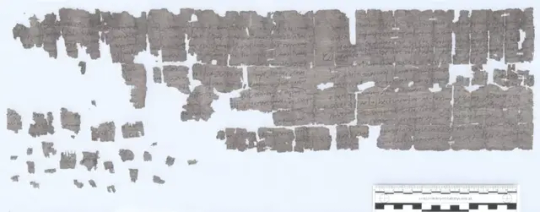
Archaeologists Find Roman Centurions' Letters in Ancient Animal Cemetery in Egypt
Discovered among the graves of hundreds of cats, dogs and monkeys, the correspondence was likely written by centurions in the first century.
An ancient pet cemetery in Egypt is becoming a gold mine for rare Roman history. Alongside its carefully constructed graves of more than 200 beloved cats, dogs and monkeys, archaeologists have now found letters handwritten 1,900 years ago by Roman centurions stationed nearby.
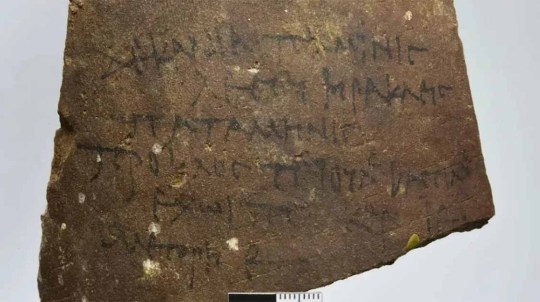
Though Rome controlled Egypt for centuries—from the year 30 to the mid-600s—few Roman sites still exist in the region, lead researcher Marta Osypińska, an archaeologist at Poland’s University of Wrocław’s Institute of Archaeology, tells Science in Poland’s Ewelina Krajczyńska. The burial ground, which dates back to the first and second centuries, is located in Berenike, a Red Sea port in southern Egypt built by Roman Emperor Tiberius.
Osypińska’s team first discovered the cemetery in 2011, and they’ve been slowly excavating it since then. Among the burials of cats, dogs and exotic monkeys, researchers have found ceramics, Roman coins and now, several letters written on papyrus by military officers who commanded units of Roman legions.
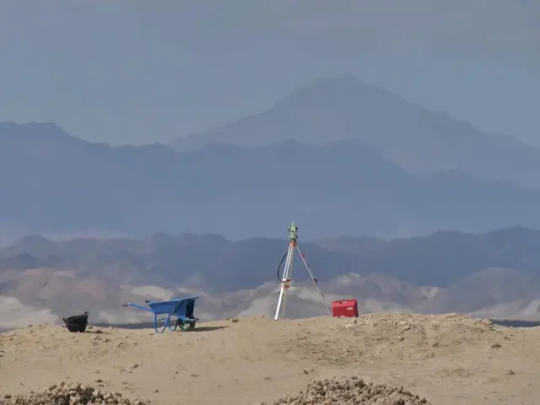
According to a statement by the University of Wrocław, these “priceless sources of knowledge about the ancient inhabitants of Berenike” are from the era of Emperor Nero, a cruel Roman ruler of the mid-first century. During his reign, Berenike was a hub of cross-continental trade, through which goods from India, Arabia and East Africa flowed, Osypińska says in the statement. The port was home to regional merchants, Roman higher-ups in charge of trading and—as historians have long suspected but never before proven—a unit of the Roman military.
The newly-found correspondence contains several names of presumed Roman centurions: Haosus, Lucinius and Petronius. In one letter, Petronius asks Lucinius, who is stationed in Berenike, about the prices of some exclusive goods, Osypińska tells Science in Poland. Petronius writes that he’s sending money via “dromedarius,” a unit of Roman soldiers traveling on camels, and tells Lucinius to provide the soldiers with veal and tentpoles.
Researchers believe ancient Romans likely kept the papyri in a nearby office which was later destroyed, accidentally distributing its contents over the pet cemetery, as McClatchy’s Aspen Pflughoeft writes. Excavators found the papyrus in rolled fragments, which they showed to Rodney Asta, an expert of ancient inscriptions, who pieced together a page approximately one and a half feet long and a foot wide, Osypińska tells Science in Poland. Among the animal graves, researchers have found countless ostracons—pieces of pottery etched with writing—but the papyri are the first paper texts to be found on-site.
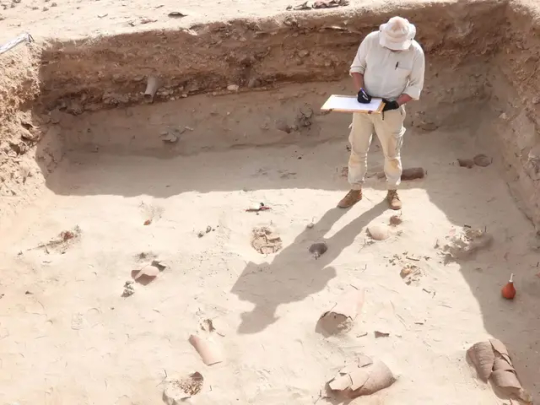
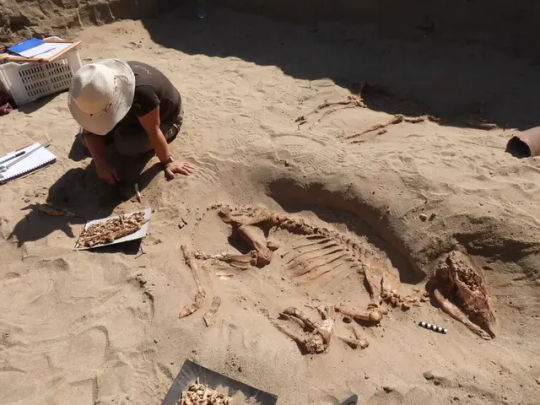
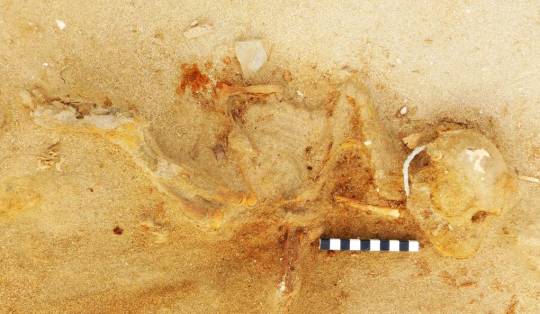
The letters are the latest evidence of advanced Roman trade to be found in the cemetery, per the statement: The skeletons of several buried monkeys, recently identified as macaques native to India, show that Romans imported non-utilitarian animals across oceans. These primates, along with long-haired cats and miniature dogs, were “elite pets,” and many were buried with toys, ceramics or other animal companions.
As Osypińska notes in the statement, it may seem difficult to reconcile the image of commanders of an ancient foreign legion with such animals, which were “treated as family members.”
“However, our findings unequivocally show that the military elite surrounded themselves with elite pets and led an exclusive lifestyle,” she adds.
By Sonja Anderson.
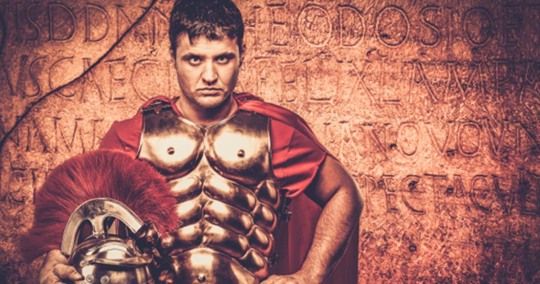
#Archaeologists Find Roman Centurions' Letters in Ancient Animal Cemetery in Egypt#Berenike#ancient pet cemetery in Egypt#Roman Emperor Tiberius#ancient artifacts#archeology#archeolgst#history#history news#ancient history#ancient culture#ancient civilizations#roman history#roman empire
74 notes
·
View notes
Text
i mentioned freid a little in this post. frêj, or فُرَيْج, furaij, means "liberation/relief from suffering."
mahad's name is arabic and means "one who is great." i'm totally pro-duke freid, even when he's being a stone cold bastard. he's dripped out and hot as hell and is an excellent complex character. the whole freid arc is impeccable, a stunning midway point to reset and explode your expectations.
so, freid is visually inspired by india during the mughal empire (a misnomer as mughal means mongol, and while the dynasty was persianised turkic, they weren't solely mongol) a multicultural empire in which the emperors were muslim. one such emperor was shah jahan, who commissioned the taj mahal as his wife's tomb. the taj mahal is a good example of what makes the era distinct, which is all of the islamic and central asian influence in the overall art and architecture while also clearly south asian. the building roofs in freid though do seem inspired by thai architecture, with the tall peaks and chofa. so they may be pulling from the yuan dynasty also.

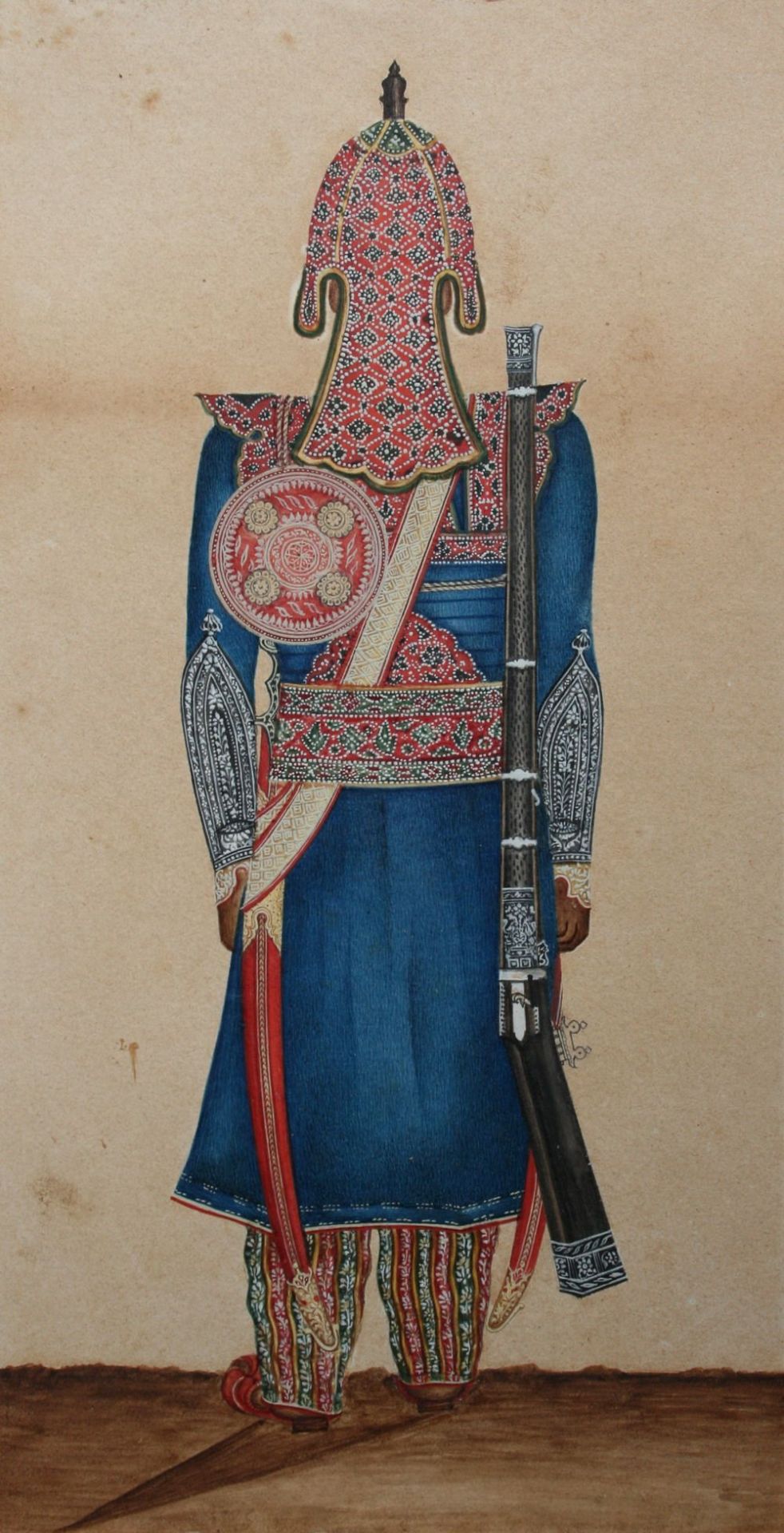






amazing cinematography. this whole scene is very economical labour-wise, but the shots don't feel that way at all. they made enough clever, striking decisions in the imagery that it feels as natural, believable as any other.


my man genghis' trident and shiva's trishul
has anyone heard of aenon? it was a place of baptism. aenon is a hellenised (ancient greek) version of the semitic term for "spring" or "natural fountain", ayn, which is also a prefix used to denote places where water can be found.
the duke's mech is named chafaris, or spelled chafariz, a portuguese word meaning fountain, which comes from the arabic ṣihrīj, meaning water tank or cistern. the first ever arabic dictionary, "Kitāb al-ʿAyn " or "The Source" is using a specific definition of ayn— "a water source in the desert" ⛲
i've said it before and i'll say it again, escaflowne is a merging of eastern and western concepts and ideas following the silk road and the history of various occupations in the region; it is not as simple as "well it's europe with some japanese flair," at all. it's inspired by nepal and tibet, and because it's inspired by nepal and tibet, that includes the rich history of the place. mecha series are almost innately political. if you want to focus on portuguese, here: spanish, portuguese, and italian all took major contributions of art, architecture, and vocabulary from arabic, and all these europeans had an invasive presence in MENA and asia. the muslims of iberia were in portugal until the 1200s. muslim spain lasted from the 700s to 1492, the toledo school was established to translate from arabic into latin. mughal/timurid empire was from the 1500s to the 1800s. portuguese india was from the 1500s to the 1960s. basra (... basram?), a port city of iran, was under portuguese control from the 1500s to 1600s. hm... maybe we can kinda ballpark some things from this :^)
wait i've just translated a section from an artbook

so it turns out i didn't NEED to do all this mental math myself, but hey ✌🏻😎
oh by the way! do theeeeese shapes look familiar to anyone?

no...? how about... this:


uh oh!
31 notes
·
View notes
Text
What was almost more remarkable than Paul’s journeys was the breathtaking rise in infrastructure and transport that enabled him to make them: in other words, the roads, grain ships, seaways and highways of the Roman Empire. Read the accounts of Paul’s travels one way, and they are a chronicle of awesome faith; read them another, and they are a chronicle of the even more awesome efficiency of Roman transport networks.
Paul might be famous for those 10,000 miles but, as the historian Wayne Meeks has pointed out, that distance is puny in comparison to the distances that others travelled in this period: the gravestone of a merchant found in Phrygia, in modern Turkey, records that he had travelled seventy-two times to Rome – a trip that is perhaps 2,000 km in either direction.
This is not to say that travel was wholly safe: it wasn’t. People consulted interpreters of dreams about travel anxieties almost more than anything else, and not without cause: as the parable of the Good Samaritan clearly shows, being beaten up and left for dead while on the road was a well-known hazard. But, nonetheless, in this period travel was being revolutionized. Within the empire, Meeks writes, people ‘travelled more extensively and more easily than had anyone before them – or would again until the nineteenth century.’
[...]
Whether or not most Romans paused to think much about it, the scale of the trade that travelled through their empire by land and by sea was staggering. Archaeologists, who have used the number of shipwrecks found at the bottom of the Mediterranean as a guide to the number of ships that once sailed on its surface, suggest it was not until the nineteenth century that Mediterranean trade regained its Roman levels.
Greco-Roman traders gained such detailed knowledge of other lands that they could write authoritative guidebooks on the quality of the water in Indian ports and what sold well there (Italian wine was, apparently, considered a particularly exotic delicacy). International trade with the subcontinent grew so much that Roman writers fretted about the trade deficit that existed between it and Rome. ‘At the very lowest computation, India, the Seres, and the Arabian Peninsula, withdraw from our empire one hundred millions of sesterces every year,’ wrote Pliny, adding, primly, ‘so dearly do we pay for our luxury and our women.’
The number of coins in circulation increased in this period, as did the production of metal. Analysis of the ice caps of Greenland show that air pollution, caused by the smelting of such metals as lead, copper and silver, would not reach Roman levels again until the sixteenth or seventeenth century.
Another measure of the high levels of trade in this era is the amount of ancient packing material that remains – in other words, of Roman pots. Amphorae, which in Roman times were used to transport more or less everything, were produced on a colossal scale. To understand quite how colossal, travel to Rome, walk southwards down the Tiber from the Colosseum, and you will see a mound, patchily covered in grass. This fifty-metre-high hillock – which is known as Monte Testaccio – is made entirely from broken oil amphorae. Inside the mound lie the fragments of an estimated fifty-three million amphorae, in which an estimated six billion litres of oil were imported into Rome.
Not only did people travel far; they also travelled fast. The speed of Roman travel, particularly for the wealthiest, was astonishing. Early in its imperial history, Rome’s emperors had set up the Roman imperial post – probably in imitation of similar systems that had been read about – and envied – in ancient accounts about Persia. This was not a post system as modern minds might imagine it, to be used by everyone, but was for imperial messengers, and its infrastructure duly demonstrated imperial ambition and grandeur: every twenty-four miles or so was a rest station; at each station, forty of the finest, swiftest horses were stabled, along with a proportionate number of grooms. A courier could therefore arrive, switch horses and set off again, and travelling in this way might cover ‘a ten days’ journey in a single day’ – in other words, it is now thought, 160 miles.
As the historian Procopius explained, emperors had set such a system up so that if there was a war, mutiny or any other disaster anywhere in the empire, the news could reach Rome fast – and it seems to have worked. The evidence for this is unusually good, because, while such disasters may have been unpleasant for the emperor experiencing them, they have been splendidly useful to later historians, since imperial deaths and assassinations tend to appear in histories with careful time stamps. They can thus be used to calculate how fast ancient travel could, in extremis, be. And the answer is: very fast indeed. After the death of Nero, for example, a messenger travelled from Rome to Northern Spain (a distance overland of around 1,800 km) in a breathless seven days. Probably that messenger did the bulk of the journey over the sea. Nonetheless, it is very, very fast.
It wasn’t just people who were on the move, either. Head to a fancy Roman dinner party and the supper on your plate could easily be as international as the guests reclining at your side, for, as one satirist put it, the ‘bottomless gullet’ and ‘tireless gluttony’ of Rome was perpetually on ‘eager quest of dainties from all quarters’. A single gourmand might, for their dinner party, source ‘a peacock from Samos, a woodcock from Phrygia, cranes of Media, a kid from Ambracia, a young tunny from Chalcedon, a lamprey from Tartessus, codfish from Pessinus, oysters from Tarentum, cockles from Sicily, a swordfish from Rhodes, pike from Cilicia, nuts from Thasos, dates from Egypt, acorns from Spain...’
-- Catherine Nixey, Heresy
14 notes
·
View notes
Text
Below are 10 featured Wikipedia articles. Links and descriptions are below the cut.
The election in 1860 for the position of Boden Professor of Sanskrit at the University of Oxford was a competition between two candidates offering different approaches to Sanskrit scholarship. One was Monier Williams, an Oxford-educated Englishman who had spent 14 years teaching Sanskrit to those preparing to work in British India for the East India Company. The other, Max Müller, was a German-born lecturer at Oxford specialising in comparative philology, the science of language.
Adolfo Farsari (Italian pronunciation: [aˈdolfo farˈsaːri]; 11 February 1841 – 7 February 1898) was an Italian photographer based in Yokohama, Japan. His studio, the last notable foreign-owned studio in Japan, was one of the country's largest and most prolific commercial photographic firms. Largely due to Farsari's exacting technical standards and his entrepreneurial abilities, it had a significant influence on the development of photography in Japan.
Girl Pat was a small fishing trawler, based at the Lincolnshire port of Grimsby, that in 1936 was the subject of a media sensation when its captain took it on an unauthorised transatlantic voyage. The escapade ended in Georgetown, British Guiana, with the arrest of the captain, George "Dod" Orsborne, and his brother. The pair were later imprisoned for the theft of the vessel.
Abu Muhammad Hasan al-Kharrat (Arabic: حسن الخراط Ḥassan al-Kharrāṭ; 1861 – 25 December 1925) was one of the principal Syrian rebel commanders of the Great Syrian Revolt against the French Mandate. His main area of operations was in Damascus and its Ghouta countryside. He was killed in the struggle and is considered a hero by Syrians.
Marjorie Cameron Parsons Kimmel (April 23, 1922 – July 24, 1995), who professionally used the mononym Cameron, was an American artist, poet, actress and occultist. A follower of Thelema, the new religious movement established by the English occultist Aleister Crowley, she was married to rocket pioneer and fellow Thelemite Jack Parsons.
Maya stelae (singular stela) are monuments that were fashioned by the Maya civilization of ancient Mesoamerica. They consist of tall, sculpted stone shafts and are often associated with low circular stones referred to as altars, although their actual function is uncertain. Many stelae were sculpted in low relief, although plain monuments are found throughout the Maya region. The sculpting of these monuments spread throughout the Maya area during the Classic Period (250–900 AD), and these pairings of sculpted stelae and circular altars are considered a hallmark of Classic Maya civilization.
The North Norfolk Coast Site of Special Scientific Interest (SSSI) is an area of European importance for wildlife in Norfolk, England. It comprises 7,700 ha (19,027 acres) of the county's north coast from just west of Holme-next-the-Sea to Kelling, and is additionally protected through Natura 2000, Special Protection Area (SPA) listings; it is also part of the Norfolk Coast Area of Outstanding Natural Beauty (AONB). The North Norfolk Coast is also designated as a wetland of international importance on the Ramsar list and most of it is a Biosphere Reserve.
Preening is a maintenance behaviour found in birds that involves the use of the beak to position feathers, interlock feather barbules that have become separated, clean plumage, and keep ectoparasites in check. Feathers contribute significantly to a bird's insulation, waterproofing and aerodynamic flight, and so are vital to its survival. Because of this, birds spend considerable time each day maintaining their feathers, primarily through preening.
The Wells and Wellington affair was a dispute about the publication of three papers in the Australian Journal of Herpetology in 1983 and 1985. The periodical was established in 1981 as a peer-reviewed scientific journal focusing on the study of amphibians and reptiles (herpetology). Its first two issues were published under the editorship of Richard W. Wells, a first-year biology student at Australia's University of New England. Wells then ceased communicating with the journal's editorial board for two years before suddenly publishing three papers without peer review in the journal in 1983 and 1985. Coauthored by himself and high school teacher Cliff Ross Wellington, the papers reorganized the taxonomy of all of Australia's and New Zealand's amphibians and reptiles and proposed over 700 changes to the binomial nomenclature of the region's herpetofauna.
Wulfhere or Wulfar (died 675) was King of Mercia from 658 until 675 AD. He was the first Christian king of all of Mercia, though it is not known when or how he converted from Anglo-Saxon paganism. His accession marked the end of Oswiu of Northumbria's overlordship of southern England, and Wulfhere extended his influence over much of that region.
26 notes
·
View notes
Text
In Israel, you’ll find a patchwork of different communities. Most Israeli Jews originate from Europe, North Africa and the Middle East, but some come from other regions, such as India.
According to the Indian Embassy in Tel Aviv, there are about 85,000 Jews of Indian origin in Israel — so Indian Jews make up just 1.2% of Israel’s Jewish population. This small community is divided into four groups: the Bene Israel from Maharashtra, the Cochin Jews from Kerala, the Baghdadi Jews from Kolkata, and the Bnei Menache from Mizoram and Manipur.
Although I grew up in the U.S., my mother’s family is from the Cochin Jewish community in Israel. I wanted to find out more about how this community is preserving our unique Jewish traditions from the South of India.
Many of these traditions are at a risk of dying out. For example, the language of the Cochin Jewish community is called Judeo-Malayalam. Today, this dialect has only a few dozen native speakers left (you can hear it spoken in this video).
According to legend, the first Jews arrived in Cochin during the time of King Solomon. The oldest physical evidence of their presence is a set of engraved copper plates dating from around 379-1000 CE, which were given to community leader Joseph Rabban by the Chera Perumal dynasty ruler of Kerala.
Jewish sailors originally arrived in Kodungallur (Cranganore), an ancient port city known as Shingly by Jews, before shifting to Cochin following a flood in 1341. These Jews became known as the Malabari Jewish community. After the expulsion of Jews from Spain in 1492, a group of Sephardic Jews also came to Cochin, and became known as the Paradesi (Foreign) Jews. The Malabari and Paradesi Jews historically lived separately and maintained their own traditions, although in modern times this division has become less important.
Today, the vast majority of Cochin Jews live in Israel. I spoke with several community members to learn about current projects in Israel to preserve Cochini Jewish culture.
Hadar Nehemya, a jazz musician and performer, runs a food delivery service sharing traditional Cochin Jewish recipes. Hadar learned the art of cooking from her mother, who learned it from her paternal grandmother.
Cooking her dishes from scratch and selling them at markets and for delivery, Hadar’s goal is to introduce Cochini cooking into the mainstream of Israeli culture. “Many Israelis don’t know much about Cochin Jewish culture. Maybe they met a Cochini person in the army,” she said. “But Indian food is popular in Israel, because Israelis love to visit India after they finish their army service.”
Cochin Jewish cuisine is similar to other types of South Indian cuisine, but also has influences from Iberian and Middle Eastern cooking. One example is pastel, pastries with a spicy filling that are similar to empanadas. Other staples include fish and egg curries, chicken stew, black-eyed pea stew, dosa (thin rice pancakes) and dishes cooked with coconut and mango.
Hadar’s favorite dishes to cook are idli and sambar, which are often eaten together. Idli is a type of savory rice cake, while sambar is a spiced lentil stew. Although Hadar says it’s difficult to maintain an Indian food business from an economic perspective, she’s passionate about cooking and enjoys creating homemade dishes with the right balance of spices.
Along with cooking, music is also important in Cochini culture. In most religious Jewish communities, women aren’t permitted to sing in front of men who aren’t their immediate relatives. However, this prohibition was not part of the Cochini tradition.
In the Cochin Jewish community, women have sung in Hebrew and Judeo-Malayalam for centuries. Piyyutim (liturgical poems) were sung in the synagogue or at people’s homes during holidays. Judeo-Malayalam folk songs were sung at weddings and special occasions, and the lyrics of these songs were recorded in notebooks to hand down to future generations. Later, many women also learned Zionist songs in preparation for moving to Israel. I have memories of my own grandmother singing these songs at home.
In recent years, audio recordings have been produced of Cochini songs, including a collection called “Mizmorim” (Psalms) featuring Hadar’s grandmother, Yekara Nehemya. Hadar then created her own version of one of the songs, “Yonati Ziv.”
Today, community leader Tova Aharon-Kastiel has organized a choir which meets once or twice a month at different locations. In the choir, Cochini and non-Cochini women, mostly aged 65-85, sing songs in Hebrew and Judeo-Malayalam. The older generation is eager for the younger generation to get involved, but since most younger Cochin Jews have a mixed background and are assimilated into mainstream Israeli culture, this is sometimes proving a challenge.
Still, many young Cochin Jews are eager to connect with their roots. The community maintains several Facebook groups, including one specifically geared towards the younger generation. The group description reads: “If you are a young Cochini, you surely know (at least partially) the wonderful heritage of our forefathers and mothers… the sad truth is that this heritage is currently on its way to pass from the world.”
Shlomo Gadot is the CEO of Inuitive, a semiconductor company, and is actively involved with Cochini community projects. His nephew, Ori, runs the Facebook group for the younger generation. Shlomo says events are regularly held at the Indian Embassy in Tel Aviv for young Cochinis. “Normally the embassy gives them their office in Tel Aviv, and they invite the young Cochini people to come there and do a trivia contest,” he said. “They do it twice a year, once at Hanukkah and once at Passover.”
According to Shlomo, the embassy also has initiatives to create connections between Indian and Israeli tech companies. “Sometimes they invite people to the ambassador’s house or office to see how they can create connections between Israeli and Indian companies,” he said. “They also have a program to bring young people to India to help them get to know India better.”
Anil Abraham is one of the few Cochin Jews with recent memories of life in India. Born in Jerusalem, his family returned to India when he was 8 years old, and he lived there until age 35 before migrating back to Israel. He says he found growing up Jewish in India difficult, but rewarding. “It was very difficult to move there from Israel and learn Malayalam,” he said. “But it was amazing to be part of the community and enjoy Cochini food prepared from scratch. We used to attend prayers in the Paradesi Synagogue, because right now there are fewer than 20 Jews in Kerala.”
Today, Anil runs tours of Kerala for the Cochin Jewish community and others. “The kids travel with their parents and grandparents to India,” he said. “That’s how our traditions are passed down.”
17 notes
·
View notes
Text
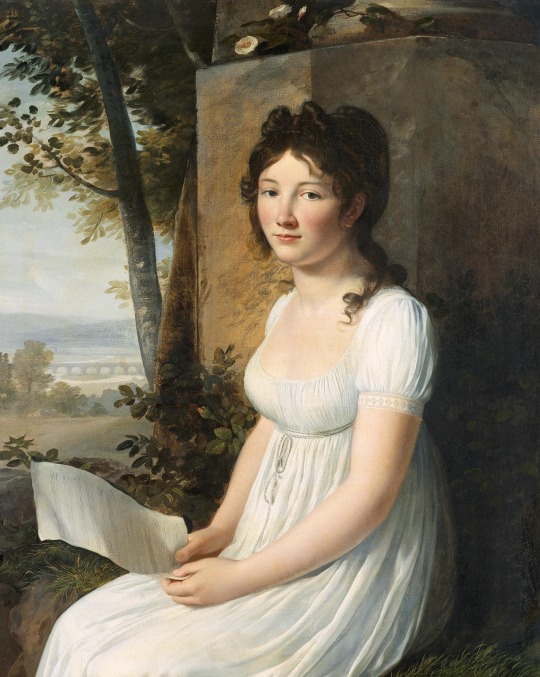
(Portrait of a young lady c. 1800-1805. Louis-André-Gabriel Bouchet. Fondation Napoléon, Paris.)
Flimsy Female Fashion in the Age of Napoleon
From NGV:
The garments worn by fashionable young women following the Revolution were famously dominated by muslin. In imitation of the ancient Greeks and Romans whose simplicity and elegance of dress was synonymous with democracy and the Roman Republic, post-Revolutionary Fashion set itself in opposition to the opulent artificiality of the Ancien Régime with its hooped and panniered skirts and elaborate embroidery and trimmings, by strutting a pared down simplicity in both style and material. Simply gathered, high waisted dresses of fine soft fabric, especially muslin, became the rage. The French interpretation of these classical garments came to be known as Empire style, whereas in England it became known as the Regency style. While muslin was the preferred fabric it came to have political and economic ramifications that were highly problematic for Napoleon.
Muslin is most typically an unbleached or white cloth, produced from finely combed cotton yarn. It originated in Northern India and first appeared in Europe in the 17th century. Becoming increasingly available with the English occupation of India in the 18th century, it found great popularity at the end of that century in France. Popular with British women in India, its open weave allowed the movement of air, and therefore was suitable for hot, dry climates. Muslin clothes were traded by ancient Greeks from the Indian port of Maisolos (or Maisala) and perhaps the name muslin originated from that place name. Marco Polo apparently praised the muslins available from India. The word muslin is also used colloquially. In the United Kingdom, many sheer cotton fabrics are termed ‘muslin’ and their uses are many; for instance, muslin is used for making various cheeses which require the milk solids to be separated from the whey.
Because the muslin trade was essentially cornered by the British, this delicate fabric had to be imported from England. This posed a serious problem for Napoleon – not only because he has closed French ports to English trade because of the hostilities between their countries (the Continental Blockade), but also because Napoleon was anxious to re-establish the textile industries in France following the Revolution. He was famously impatient with women around him who continued to wear muslin and was known to lose his temper with both Josephine and his step-daughter, Hortense, reportedly either tearing their fashionable dresses or spoiling them by dousing them with coffee and officially banning the wearing of muslin. His reasons were serious (though his temper must have been irksome) and connected with propping up France’s textile industry. He required formal dress to be worn at all times at court, thereby reintroducing a clientele for silks and velvet largely made in Lyon.
(Source)
61 notes
·
View notes
Text

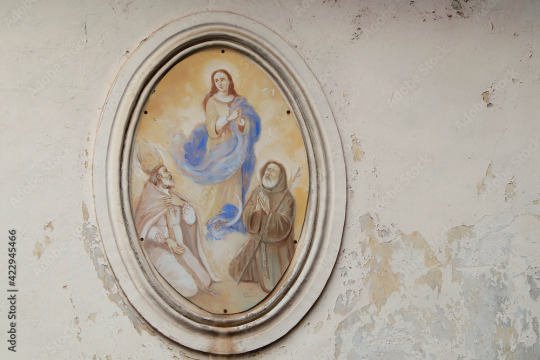
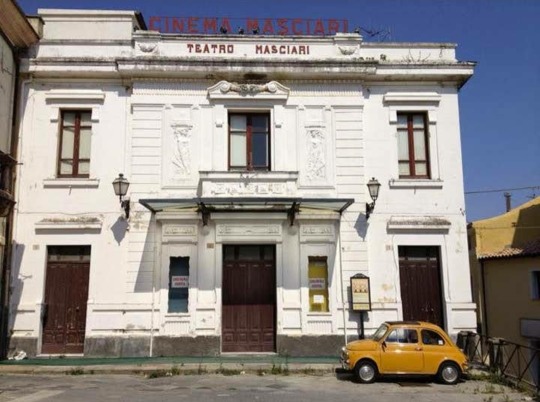
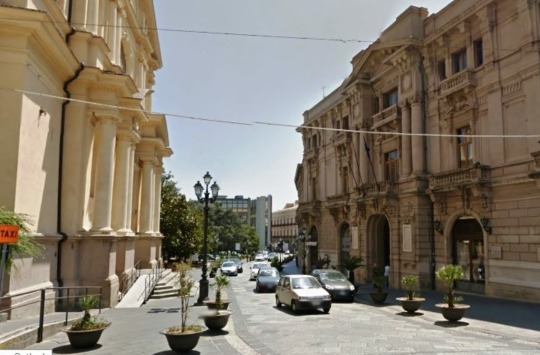
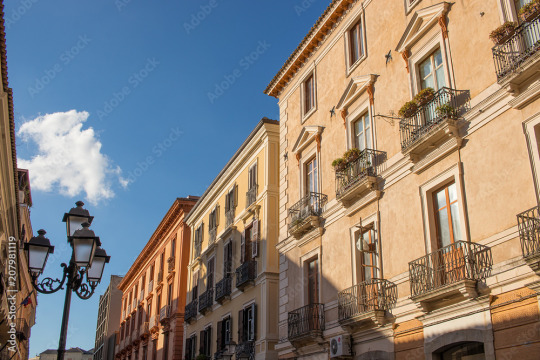

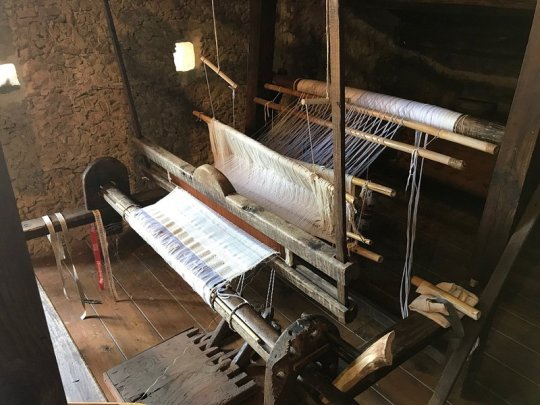
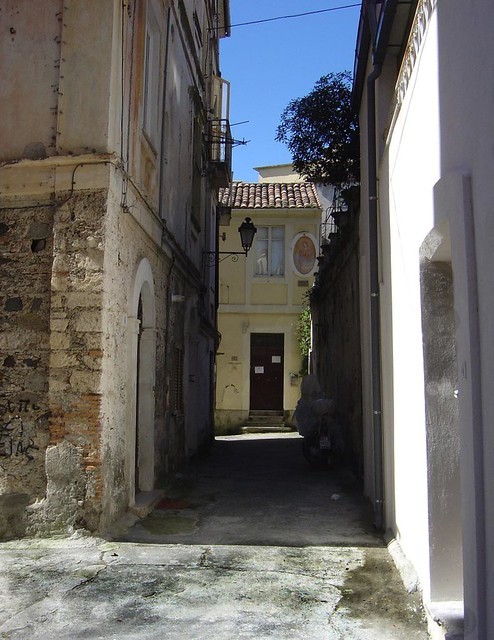

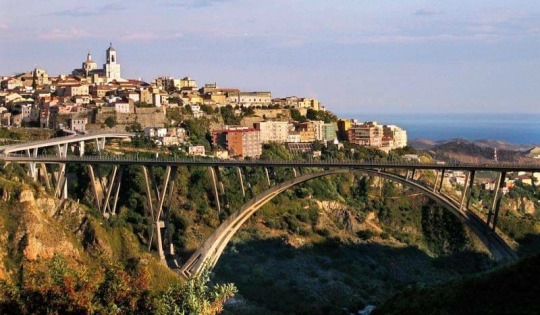
Catanzaro, Calabria, Italy
This ancient town which rises on a rock is the capital of the Calabria region. It was founded in 9th century by the Byzantines and was built over three hills in order to protect the town from the Saracen attacks arriving from the lonian sea.
At the beginning of the tenth century (c. 903), the city of Catanzaro was occupied by the Muslim Saracens, who founded an emirate and took the Arab name of قطنصار - Qatanşār.
An Arab presence is evidenced by findings at an eighth-century necropolis which had items with Arabic inscriptions. Around the year 1050, Catanzaro rebelled against Saracen dominance and returned to a brief period of Byzantine control.
Under the Byzantine dominion, between the end of the 9th and the beginning of the 10th century, Calabria was one was one the first places in Italy to introduce the breeding of the silkworm in the 11th century.
According to French historian André Guillou, mulberry trees for the production of raw silk were introduced to Calabria by the Byzantines at the end of the 9th century. Mulberry leaves are the only leaves that silkworms eat.
Around 1050, the theme of Calabria had cultivated 24,000, mulberry trees for their foliage, with growth still ongoing.
The peasants of the countryside around the city produced the raw silk, which was then woven in the silk workshops of Catanzaro. A large part of the population was involved in this business, and the silk of Catanzaro supplied almost all of Europe.
The silk was sold in a large market fair in the port of Reggio Calabria, to Spanish, Venetians, Genovese and Dutch merchants.
Today, three young friends have come together to bring local traditions back to the fore. In 2014 they decided to build their future in San Floro, a tiny village of 600 inhabitants near the city of Catanzaro and restore the traditional mulberry tree planting and cultivation needed for the rearing of silkworms. Historically, San Floro was famous for a very significant production of raw silk in the 17th century, though this heritage had been completely lost in modern times.
The only surviving elements of this rich legacy were the 3,000 abandoned mulberry trees and the memory of the elderly villagers. Miriam and her friends brought back the production of silk, rewinding the threads of history and travelling across the world to exchange best practices with silk institutes in Thailand, India, Switzerland, and France.
As part of its development, they trained people interested in their new, sustainable production model and also brought thousands of tourists from all over the world to visit their farm (Nido di Seta) to experience how silk is produced first-hand.
Catanzaro is a windy city due to its altitude and position between two seas. In fact, there is only 30 km separating the Ionian Sea from the Tyrrhenian Sea and Catanzaro is wide open to the constant strong breezes from the Ionian Sea and the Sila mountains.
Follow us on Instagram, @calabria_mediterranea
#catanzaro#calabria#italy#italia#south italy#southern italy#italian#mediterranean#silk#the silkworm#silk road#europe#architecture#textile#loom#mulberry tree#history#muslim#saracens#italian landscape#landscape#mediterranean sea#arab#byzantine#byzantine empire#weaving#nido di seta
23 notes
·
View notes
Text
The divine blend of spices needed to make curry first reached Southeast Asia about 2,000 years ago, when the region began trading with the Indian subcontinent, according to an analysis of ancient spice residue.
The new project analyzed 12 different spice grinding tools unearthed at the ancient trading port of Oc Eo, in modern-day Vietnam, by washing them with water and chemicals. This produced hundreds of tiny fragments that the researchers painstakingly identified (to a reasonable degree of certitude) under a microscope. The results sounded like a shopping list for making curry: turmeric, ginger, fingerroot, sand ginger, galangal, clove, nutmeg and cinnamon.
“These spices are indispensable ingredients used in the making of curry in South Asia today,” the paper says.
Ancient Trading Spices
Where did all these spices comes from?
They could have come from the surrounding countryside. Farmers in Southeast Asia made many of these crops themselves, and if not, they could have imported the seeds and gotten started.
On the other hand, the turmeric could have easily come from India, where use of the spice dates back thousands of years. And the ginger and cloves may have come from India as well, or maybe China.
Cinnamon was widely traded at the time and may have come all the way from Israel.
The galangal, fingerroot and sand ginger are native to Southeast Asia and could easily have come from nearby soils. These more specialized spices are still used in the region’s curry paste.
Footed Grinding Slabs
As a testament to the spice trade’s popularity, the spice grinders made up the majority of the stone tools recovered from Oc Eo and another, nearby city called Angkor Borei. The original archaeological dig at Oc Eo found numerous footed grinding slabs, which look like little stone workbenches for grinding spices – which is what they likely were. Versions of these slabs are still sometimes used in the traditional preparation of curry.
The largest slab recovered measured 2.5 feet by 1 foot. Researchers found it buried not far from a piece of charcoal that dated to about A.D. 250, which hinted at when curry first made its way to the area.
Oc Eo
At that time, the city would have been not just importing and exporting goods but making them as well, according to the paper. Residents raised religious monuments and shaped metal tools, glass jewelry and pottery.
All the while, they would have worked to trade and process many different spices. Archaeologists working there even found an intact nut that dated to about A.D. 200, and it still “yielded a nutmeg aroma,” the paper says.
Now part of Vietnam, Oc Eo once belonged to the ancient kingdom of Funan, which maintained a base of power further up the Mekong River.
In Oc Eo, culture prospered between the first and eighth centuries, during the latter years of the Iron Age. As the site’s ancient canals filled with ships, Buddhism and Hinduism left their own marks on the sprawling complex, including a possible contribution to curry cooking. The need to dye the Buddhist monks’ robes yellow may have first prompted Oc Eo to import turmeric, the paper says.
78 notes
·
View notes
Note
As Alexander conquered more territories, he seems to have widened his list of royal titles. So, aside from being king of Macedon, he also became pharaoh of Egypt and king/emperor of Persia (king of kings? King of Asia?). Did Alexander actually invest himself with these titles in any official capacity?
Also, based on his adoption of titles (or not), should we see Alexander's vast dominions as one articulated empire, as in, everything was kingdom of Macedon, or should we understand his domains more in the basis of a “personal union” of many countries united under the same monarch?
How Alexander understood his new empire is unclear, in part because he seemed to be figuring it out as he went. Also, because he’d made a second round of changes in the spring/summer of 324 BCE, after he’d returned from India, but these may not have been entirely done before Hephaistion died—then Alexander himself. (The first set of changes were the summer/fall of 330.)
I think it safe to say he saw it all as far beyond “Greater Macedon,” based on his modifications, starting with the spring Susa weddings (top Macedonian officers to Persian noblewomen). Then in the summer, while he was in Opis, he reorganized the army (again), including the introduction of a Persian unit of Companion Cavalry, as well as the 30,000 “Epigoni,” the young Persian (aristocratic) boys who’d been trained in the use of the Macedonian sarissa. This SO incensed the rank-and-file, it caused the infamous mutiny (together with the dismissal of older and disabled veterans). His formal court appearances also began to feature not only Macedonian guards (Hypaspists), but also Persian, albeit in separate units. This general period may also be when he formally appointed Hephaistion Chilliarch.
As for titles, as far back as 330, he began styling himself “King of Asia”—which wasn’t the title traditionally employed by Achaemenids: Kshayathia Kshayathiyanam (Xšāyaθiya Xšāyaθiyānām), “Great King” or “King of Kings,” Shahanshah in Middle Persian. He knew the title perfectly well, so it was a clear choice not to use it, and nothing in our sources suggest he went through the traditional enthronement for Persians kings … nor for the Egyptian pharaoh, either. There’s been some debate about the latter, but these days, I believe the majority opinion is that he simply wasn’t in Memphis long enough. He was in a hurry to chase Darius.
IMO, too much significance is given to his time in Egypt, his claim to Ammon’s sonship notwithstanding. It’s not that Egypt wasn’t important, but it later gained a disproportionate prominence due to hindsight. I do think he had high goals for Egyptian Alexandria, especially for trade (he knew a good port when he saw one), but I’d say he had an equal intention to elevate Babylon. One was a completely new city, the other, the heart of old Mesopotamia … but long enough outside the seat of power that he could return it to that status without appearing to sit in the shadow of the Achaemenids.
So he was trying to create something new, but with enough ties to prior kingships that it wouldn’t offend. Recall that in the ancient world, “new” was not a virtue. Today, the “fresh, new” approach is sought after, but back then, tried and proved and traditional was preferred.
#asks#Alexander the Great#Alexander the Great's Empire#“King of Asia”#Alexander's plans for his empire#Classics#ancient history#ancient Macedonia#ancient near east
16 notes
·
View notes
Photo

Paul's Journeys and the Mediterranean Trade
Mediterranean trade increased exponentially at the turn of the first millennium. During Rome's zenith, goods of all sorts began to move in all directions. As a common traveler aboard merchant ships, Paul traveled within such a milieu. Tracing the water portion of his journeys in the New Testament can shed light on general trade patterns in the Mediterranean Sea areas.
Exotic Animal Transportation, Villa del Casale
Unknown Artist (Public Domain)
Trade at the Turn of the Millennium
As the Roman Republic in the latter centuries of the last millennium BCE began to conquer the littoral nations around the Mediterranean – including Europe, Northwest Africa, and Anatolia, the Mediterranean Sea indeed became, to the Romans, Mare Nostrum, "our sea." Then, with Rome's takeover of Syria, Phoenicia, and Egypt, by the time of Paul the Apostle, Rome's encirclement of control was complete. Rome became the main market for agricultural, material, and refined goods that, as a result, moved largely from East to West. Then, as the extent of the Roman Empire grew, followed by the colonization and urbanization of its eastern provinces, the empire's eastern half began to develop a degree of commercial autonomy that created an interactive network of activity.
Around 200 BCE, goods from the East moved through Mesopotamia to the Levant and Anatolia by overland routes from India and by water up the Persian Gulf, which was then taken by camel to Seleucia, near modern-day Bagdad. Another route in the Eastern trade network of ancient Rome was goods sailing from the northwestern ports of India to Alexandria via the Red Sea. However, by the early Augustan period, with Rome's eventual control of Arabia and the Red Sea, there began a dramatic increase in Eastern items moving west to Rome, including silks, decorated cotton, shells, tortoiseshell, coral, ivory, nard, aloe, frankincense, myrrh, and spices like pepper, cinnamon and cassia.
Adding to Rome's consumption, with 300,000 veterans of the Roman army to find land for, Augustus (r. 27 BCE to 14 CE) established 75 colonies throughout the empire. According to Nigel Rodgers, "All these generally small settlements – usually a couple of thousand veterans, growing perhaps into a city of 10-15,000 – helped the urbanization and Romanization of the empire" (87). Additionally, as the eastern Roman provinces began to mirror Rome in structure and taste, demand for the same goods increased. Those goods would, therefore, begin to travel not just west to Rome but were manufactured and traded in all directions. It was this commercial environment in which the journeys of Paul the Apostle took place.
Continue reading...
28 notes
·
View notes
Note
I suddenly remembered that one line from Desmond as Al Mualims daughter ask where Desmond was craving a cheese burger and Al Mualim sent Assassins to find it and it got me thinking so I searched up if it was possible but all I got were from the middle ages so I wanna know your take if a cheese burger can be made during that time
The Desmond is reborn as Al Mualim’s daughter post, the “I misunderstood the ask so now Al Mualim has a wife oops” follow up idea and its sequel, the “Eli POV”, for those curious.
Okay, so there’s a lot of variations of the cheeseburger. For the sake of analyzing if it’s possible to recreate a cheeseburger in 12th century Levant, let’s go for the ‘basics’:
Bun
Cheese that can be melted
Patty (ground beef)
Lettuce
Tomato
Onion
Pickles
Sauce
Let’s start with the parts that needs to be 'prepared':
Buns can easily be recreated with flour, yeast, milk, egg, sugar, salt and butter or oil. Sesame seed that will sprinkled on top is optional but can be gotten in Egypt since they seemed to have it during Ptolemaic period as ‘sesemt’.
Patty can be prepared using ground beef (I’m sure Al Mualim would have no problem getting novices/recruits to chop the beef enough for it to be grounded, good luck, you poor boys), salt, ground black pepper, egg and dry bread crumbs. The lost ancient port city of Muziris is said to have exported black pepper to Levant.
Salt for both the buns and patty is possible to get during that time as well. It’s gonna be expensive though XD
Now, for the other ingredients:
Lettuce – it’s originally farmed in ancient Egyptians so they can find this easily.
An onion variation/ancestor has been noted in Iran so they can contact Alamut for this.
Cucumber for the pickles is available in India and other East Asian countries so their best bet would be the Silk Road. Pickling would need vinegar which should be available already by that time (vinegar has been available since alcohol brewing has been a thing… maybe…) (this needs salt as well)
Tomato – They’d need to sail to America for this one. Time to get into contact with Ratonhnhaké:ton’s tribe, I guess. XD
The sauce though is a bit complicated. Cheeseburger usually use thousand island for the sauce but that would mean ketchup and mayonnaise. Ketchup needs tomato as well so… yeah. (of course, the sauce can be something else but then… it won’t be a classic cheeseburger if it’s not at least mayonnaise and homemade mayonnaise is… uuuhh… good luck, novices and recruits)
Now… the cheese…
American cheese is… well… sorta maybe impossible? XD
It would be too much to try and create even a Swiss or Cheddar cheese for this one so what will make or break this cheeseburger endeavor will be the cheese.
It needs to be a type of cheese that can be melted…
Or…
Well…
They do have the Apple so they can cheat it to learn how to make that kind of cheese themselves XD
(all information taken from wikipedia)
#i never knew i would research if it’s possible to make a cheeseburger#in 12th century levant#when i made this tumblr XD#it was fun though#researching is fun for me hahahaha#the black pepper part i already researched before#for eagle of alamut#ask and answer#no usual tags because#the og ask was#altdes
24 notes
·
View notes
Text
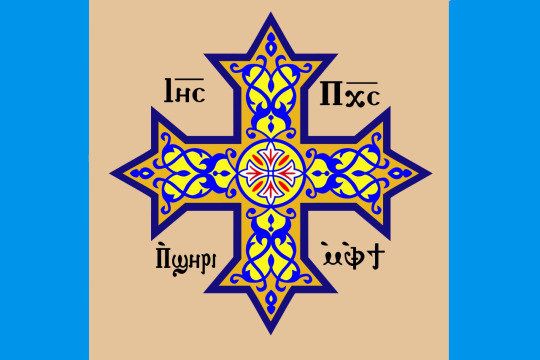

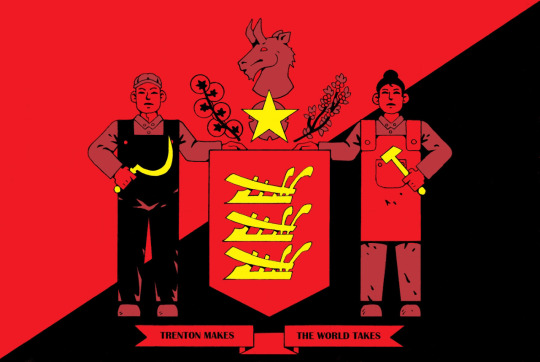
People’s Flag Wars: Round 1, Bracket 11
See the symbolism below.
Coptic Egypt is a flag by @arthurdrakoni.
Symbolism: “This is the flag of Coptic Egypt. It comes from a world where Islam was never founded. One of the many consequences of this was that the Byzantine Empire continued to prosper for a number of years. Eventually, however, tensions began to grow within the empire. Egypt began to feel that Constantinople was giving them the short end of the stick a bit too often. Egypt's main grievances were increased taxes and increased tensions between the Coptic and Orthodox churches. After a brief war, Egypt was granted its independence. Despite this, Egypt retains good relations with Byzantium. It also maintains good relations with fellow Oriental Orthodox nations Ethiopia and Armenia. Egypt has traditionally been a hub of trade, and following its independence work began on a canal in the Sinai Peninsula. Egypt established traditions ports in India and China. It also established colonies in Australia, which is known as New Egypt, as well as a few minor colonies in South America.
The wealth from its trade and colonies has made Egypt a very rich nation. People and goods from throughout the world can be found across Egypt's cities. Currently there is something of an architectural fad based around reinterpretations of Ancient Egyptian architecture. Egypt also has a reputation for having some of the best universities and centers of learning in the world. It is a nation which honors its past while keeping an eye towards the future.
The flag contains a Coptic Cross to represent Egypt's Coptic faith. The background represents the sands of Egypt, while the blue bands stands for the waters of the Nile River. The writing is in the Coptic Script and reads "Jesus Christ, Son of God".”
Forest City Flag is a flag by @forestcityflag.
Symbolism: “The Forest City is a new flag for Cleveland, highlighting both our history and environment. The blue top half represents Lake Erie, our very own inland sea. The green bottom half represents the Forest City nickname and the Emerald Necklace of our Metroparks. The wavy chevron in the center represents the Cuyahoga River winding its way through downtown. The pattern is inspired by a design from Moses Cleaveland's coat of arms (he's the guy who invented Cleveland). At the same time, the upward facing arrow is reminiscent of the city's motto "Progress and Prosperity," pointing up towards the future.”
New Jersey Autonomous Zone is a flag by @lil-tachyon.
Symbolism: “The design is based on the original New Jersey flag but re-imagined in the context of some kind of anarcho-communist future. The buff field of the NJ flag is replaced by the bisected black/red used by anarcho-communists and syndicalists. The coat of arms has the godesses Liberty and Ceres replaced by workers wielding a sickle and hammer, the horse head replaced by the head of the Jersey Devil, a yellow Star backed by a slice of pork roll replacing the helmet, and tomatoes and cranberries flanking the star. The motto is changed from "Liberty and Prosperity" to "Trenton Makes, The World Takes," the words infamously featured on the Lower Trenton Bridge.”
20 notes
·
View notes
Text
Flag of Coptic Egypt
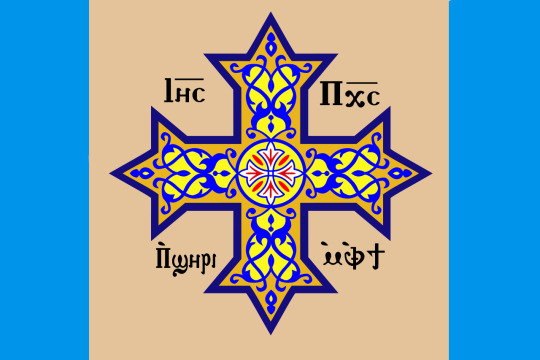
This is the flag of Coptic Egypt. It comes from a world where Islam was never founded. One of the many consequences of this was that the Byzantine Empire continued to prosper for a number of years. Eventually, however, tensions began to grow within the empire. Egypt began to feel that Constantinople was giving them the short end of the stick a bit too often. Egypt's main grievances were increased taxes and increased tensions between the Coptic and Orthodox churches.
After a brief war, Egypt was granted its independence. Despite this, Egypt retains good relations with Byzantium. It also maintains good relations with fellow Oriental Orthodox nations Ethiopia and Armenia. Egypt has traditionally been a hub of trade, and following its independence work began on a canal in the Sinai Peninsula. Egypt established traditions ports in India and China. It also established colonies in Australia, which is known as New Egypt, as well as a few minor colonies in South America.
The wealth from its trade and colonies has made Egypt a very rich nation. People and goods from throughout the world can be found across Egypt's cities. Currently there is something of an architectural fad based around reinterpretations of Ancient Egyptian architecture. Egypt also has a reputation for having some of the best universities and centers of learning in the world. It is a nation which honors its past while keeping a eye towards the future.
The flag contains a Coptic Cross to represent Egypt's Coptic faith. The background represents the sands of Egypt, while the blue bands stands for the waters of the Nile River. The writing is in the Coptic Script and reads "Jesus Christ, Son of God".
Link to the original flag on my blog: https://drakoniandgriffalco.blogspot.com/2016/10/flag-of-coptic-egypt.html?m=0
#alternate history#alternate history flag#alternate history flags#flag#flags#vexillology#egypt#Coptic Egypt#coptic#Copts#Egyptian Copts#Coptic Egyptians#byzantine empire#Byzantium#eastern roman empire#Orthodox
32 notes
·
View notes
Text

Sketch of a Haida cargo ship off the coast of Xaaydaga Island in the Haida Gwaii, 2314 AD.
The Haida have become the masters of the North Pacific, transporting goods along the west coast of North America, as well as making the 6-8 week long trek in the summers across to the Yellow Sea Alliance (YSA). They have seen great success via combining algae diesel fuelled engines with junk rigged sails on a two mast schooner type ship. They are the main mover of goods and people from Port Baja (the southern most point the Haida bother to go), up to Seattle Bay, then Haida Gwaii and Terace serves as the central hub. Then will up to Sugpiaq, then to Adak (which serves as the main rest stop between Asia and North America), out to Yelizovo, and finally to Hokkaido.
Nunangat controls Sugpiaq and, in turn, transports goods along the northwest passage, down the east coast and even out to Iceland connecting Europe to the Americas. From Hokkaido, the YSA moves goods southward and out to India, and from Yelizovo, ancient Russian infrastructure takes tribal caravans deep into the Eurasian continent. As such, the Haida serve a vital role in what has been called "The Great World Ring," a trade road moving things across the entire globe. Many people have managed to circumnavigate the globe just by moving from trade ship to trade ship to caravan to trade ship. While perhaps the world isn't as prosperous as before The Flood Wars, it does not mean there is no global community.
#solarpunk#steampunk#science fiction#scifi#scifiart#pacific ocean#solarpunk art#art#decolonize#decolonization#indigenous fiction#indigenous futurism#indigipunk#canada#british columbia#japan#inuit#haida#haida gwaii#north america
6 notes
·
View notes